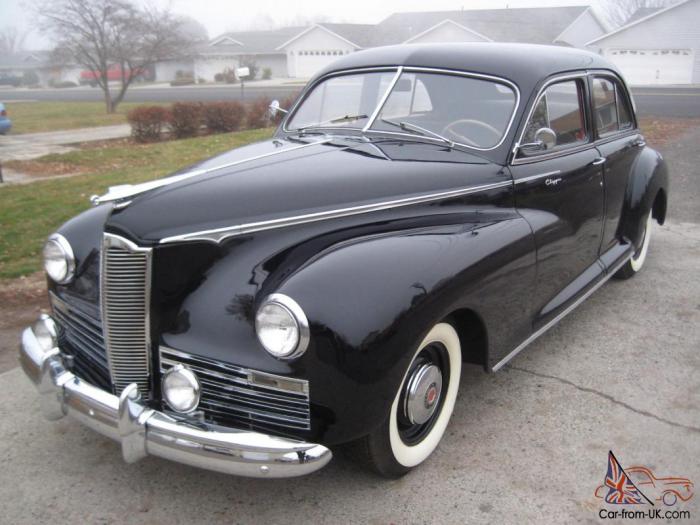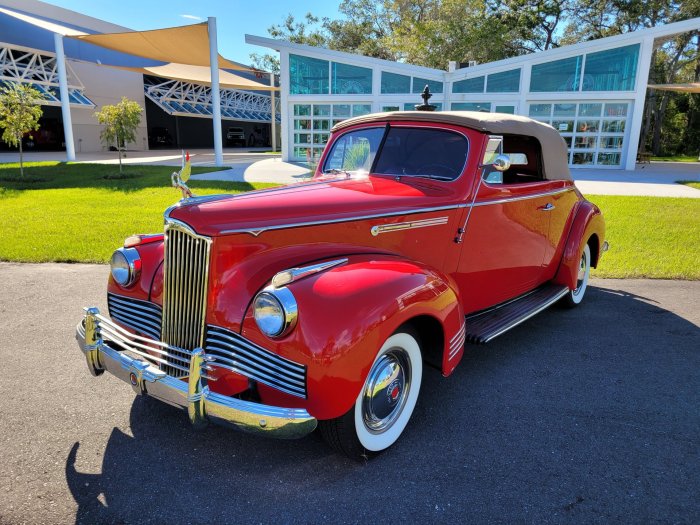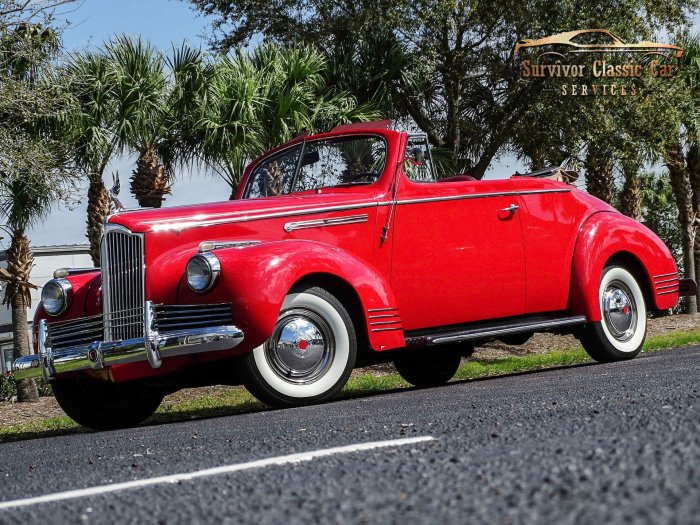The 1942 Packard 110 stands as a testament to American ingenuity and resilience during World War II. This luxury automobile, crafted by the renowned Packard Motor Car Company, embodies a fascinating blend of wartime constraints and enduring elegance. Despite the challenges of wartime production, the 1942 Packard 110 emerged as a symbol of American strength and refinement, offering a glimpse into a bygone era where style and performance intertwined.
The 1942 Packard 110, a symbol of American automotive prowess, was designed and built during a time of unprecedented global upheaval. The war effort demanded the redirection of resources, forcing the automotive industry to adapt and innovate. The 1942 Packard 110, a testament to this period of transition, reflects the compromises and innovations that defined the era.
Its sleek exterior, while retaining the classic Packard elegance, incorporated practical considerations, showcasing a blend of style and functionality that defined the wartime aesthetic.
Historical Context

The year 1942 was a pivotal moment in American history, marked by the nation’s full-fledged entry into World War II. This global conflict had a profound impact on all aspects of American life, including the automotive industry. The war effort demanded the redirection of resources and manpower, significantly impacting the production of civilian vehicles.
The Packard Motor Car Company, known for its luxury automobiles, played a crucial role in the war effort. The company shifted its focus from producing civilian vehicles to manufacturing essential war materials. Packard’s expertise in engineering and manufacturing contributed to the production of vital equipment for the Allied forces.
Wartime Production Constraints and Their Impact
The war’s demands led to significant constraints on the automotive industry, influencing the design and features of the 1942 Packard
110. These constraints included
* Material Shortages:The war effort required the prioritization of resources for military production, leading to shortages of essential materials like steel, rubber, and aluminum.
Labor Shortages
With a large portion of the workforce joining the military, the automotive industry faced a significant shortage of skilled labor.
Government Regulations
The government implemented strict regulations to control the production and distribution of civilian vehicles. This included limitations on the use of materials, engine size, and model variations.These wartime constraints influenced the design and features of the 1942 Packard 110 in several ways:* Simplified Design:To conserve materials and expedite production, the 1942 Packard 110 featured a simplified design with fewer chrome accents and embellishments.
Reduced Features
The 1942 Packard 110, a car known for its sleek lines and powerful engine, was a stark contrast to its predecessors. While the earlier models, like the 1935 Packard Eight , exuded a more opulent and traditional aesthetic, the 110 embraced a streamlined design that was indicative of the changing times.
This shift in design philosophy reflected the evolving automotive landscape, where functionality and performance were becoming increasingly important.
Some luxury features, such as power windows and radios, were omitted to prioritize essential components and materials.
Engine Size Reduction
The 1942 Packard 110 featured a smaller engine compared to previous models, complying with government regulations and maximizing fuel efficiency.
Limited Color Options
To streamline production, the 1942 Packard 110 was offered in a limited range of colors.
Increased Durability
Despite the simplifications, the 1942 Packard 110 was designed for increased durability, reflecting the need for reliable vehicles in wartime conditions.
Design and Features
The 1942 Packard 110, despite being produced during wartime, was a testament to Packard’s commitment to elegant design and luxurious features. It showcased a distinct blend of classic styling and modern touches, establishing itself as a prominent symbol of American automotive excellence during a challenging era.
Exterior Design
The 1942 Packard 110’s exterior design embodied the classic American luxury car of the era. It featured a long, flowing hood, a spacious body, and a distinctive grille that defined the Packard identity. The grille was comprised of vertical chrome bars that extended down to the bumper, creating a bold and elegant front end.
The car’s profile was characterized by smooth, sweeping lines and a pronounced rear deck.
Interior Design
The 1942 Packard 110’s interior was a haven of luxury and comfort. The use of high-quality materials was evident throughout, with plush leather upholstery, wood trim, and intricate details. The dashboard featured a classic design with an array of gauges and controls, all carefully arranged for easy access.
The spacious cabin provided ample room for passengers, with generous legroom and headroom.
Interior Features
The 1942 Packard 110 offered a range of features designed to enhance comfort and convenience. Standard features included:
- Power windows
- Power seats
- Radio
- Heater
- Air conditioning (optional)
Technical Specifications
The 1942 Packard 110 was powered by a robust 356 cubic inch straight-eight engine, capable of producing 160 horsepower. This engine was paired with a three-speed manual transmission, which delivered smooth and responsive performance.
Suspension and Chassis
The 1942 Packard 110 featured a durable and comfortable suspension system, designed to provide a smooth ride on even the roughest roads. The front suspension utilized a live axle with semi-elliptical leaf springs, while the rear suspension employed a live axle with Hotchkiss drive and semi-elliptical leaf springs.
The car’s robust chassis was built to withstand the rigors of daily driving, ensuring a long lifespan.
Production and Availability

The 1942 Packard 110 was a car produced during a time of great upheaval, with the United States on the brink of entering World War II. As such, production numbers were limited, and the car’s distribution was impacted by the wartime economy.The 1942 Packard 110 was a luxury car aimed at a discerning clientele.
Packard’s marketing efforts focused on emphasizing the car’s quality, performance, and prestige.
Production Numbers
Production of the 1942 Packard 110 was limited due to the impending war. The exact number of units produced is not publicly available, but it is estimated to be significantly lower than in previous years. Packard shifted its production focus to war-related materials, leading to a decline in the number of civilian vehicles produced.
Distribution Channels
The 1942 Packard 110 was distributed through a network of authorized Packard dealerships across the United States. Packard dealerships were typically located in major cities and served as points of sale, service, and parts distribution. The dealerships catered to a wealthy clientele who valued the prestige and exclusivity of the Packard brand.
Target Market
The 1942 Packard 110 was targeted at affluent individuals and families seeking a luxurious and well-appointed automobile. The car’s price point, features, and marketing emphasized its status as a premium vehicle. The target market included successful businessmen, professionals, and individuals with a strong appreciation for fine craftsmanship and engineering.
Comparison with Other Packard Models, 1942 Packard 110
The 1942 Packard 110 was positioned as the entry-level model in the Packard lineup, offering a balance of luxury and affordability. It was smaller and less powerful than the flagship Packard 180, but still offered a high level of refinement and comfort.
The 1942 Packard 110, a classic American luxury car, exemplified the brand’s commitment to elegance and performance. While the 110 shared some design elements with its predecessor, the 1941 Packard Business Coupe , it introduced a more refined grille and updated interior.
The 1942 Packard 110 remains a highly sought-after collector’s car, embodying the era’s automotive artistry and engineering prowess.
The 110 also shared many design elements with other Packard models of the era, including the distinctive grille and flowing lines.
Legacy and Impact: 1942 Packard 110

The 1942 Packard 110, while produced in limited numbers due to wartime restrictions, played a pivotal role in shaping Packard’s design and engineering philosophies, leaving a lasting mark on the automotive landscape. It was a testament to the company’s commitment to luxury and innovation, even in the face of adversity.
Cultural Impact and Automotive Significance
The 1942 Packard 110, despite its limited production, became a symbol of American automotive excellence during World War II. Its elegant design and powerful engine were admired by many, and its association with the war effort further cemented its place in American culture.
The car’s presence on the home front served as a reminder of the nation’s industrial prowess and its ability to produce high-quality goods even during a time of crisis. The 1942 Packard 110’s design, particularly its distinctive grille and streamlined body, influenced subsequent Packard models and contributed to the company’s reputation for producing stylish and luxurious automobiles.
Collectible Value and Restoration Efforts
Today, the 1942 Packard 110 is a highly sought-after collectible, particularly among enthusiasts of classic American automobiles. Its rarity, combined with its historical significance and elegant design, makes it a prized possession. The car’s restoration efforts are often extensive, requiring specialized knowledge and expertise.
Due to the limited production and the challenges of sourcing original parts, restoration can be a demanding and costly process. However, the passion of Packard enthusiasts and the dedication of restoration specialists ensure that these vehicles are preserved for future generations to appreciate.
Last Point

The 1942 Packard 110 remains a captivating relic of a pivotal period in American history. It embodies the spirit of resilience, ingenuity, and unwavering elegance that defined the era. As a collector’s item, it continues to evoke a sense of nostalgia and admiration for the automotive craftsmanship of a bygone era.
Its legacy transcends its time, reminding us of the enduring impact of American ingenuity and the timeless allure of classic automobiles.